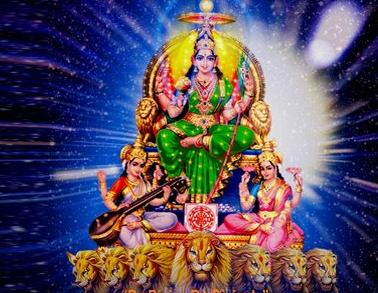In Namams 381 to 474, the Divine Mother’s Jnana Yoga worship methods are discussed in details.
The Divine Mother is in the forms of both knowledge (vidya) and ignorance (avidya).
Universal beings have a sense to understand things; in some one has good understanding and in some others have ignorance. It is difficult to determine those things where the difference of knowledge and ignorance exist. Sometimes, we can draw the differentiating line between knowledge and ignorance. The ones above the line are vidya; the ones below the line are ignorance or avidya. A well matured human is being said to have fine knowledge and superlative skills. He becomes an example for vidya form. All those below are avidya form, even though these beings may have some lower level knowledge.
Plants have a sensing item to grow upwards. Ant has three sensory items and some of its actions are better than humans. Bees have five sensory items; they provide good help to mankind. Whereas, the humans with all senses, have vidya (knowledge) and avidya (ignorance) forms. Humans can graduate towards Brahman. The Divine Mother is operating in all these universal beings in vidya and avidya rupam.
Philosophically, the infinite universe and its creation are at the lower level and some in confused state in avidya rupam. Even the creative Lord Brahma is also included in lower level of created being, whereas the Supreme Brahman is vidya rupam. The Divine Mother is there in all these; so She is vidya and avidya rupini.
Knowledge (vidya) helps to understand the true nature of the soul. Karma kandam says to submit to Isvaran our karma; it gives determination and purity of heart even though Karma is part of avidya. So the Divine Mother is in all rupams, “vidyavidya”.
The difference between knowledge and ignorance can be explained as follows: When someone says, “I am the Self”, the knowledge (vidya) is reflected. When he says, “I am the body”, it is realization of ignorance (avidya). Perception of oneness with Brahman is vidya and perception of plurality is avidya. Again, the attitude that, “Lord makes me do everything” is vidya and the attitude that, “I do all is avidya”. The attitude that I am neither the doer nor the experience, but pure consciousness, is vidya; the attitude that, “I am the doer and the experience” is avidya.
According to Linga Puruana, “Shiva has three forms: Bhranti (confusion), Vidya and Para. The knowledge of many forms, plurality is Bhranti; the knowledge of the Atman is Vidya and the knowledge of Brahman without any ambiguity is Para (Supreme).
One who discriminates between knowledge and ignorance partakes of the nectar of immorality; the Divine Mother, of course, is the one who initiates this. One who immerses himself in the river of ignorance goes through thousands of cycles of ‘repeated birth’ and repeated deaths’ often lying in mother’s womb. That, too, is due to power of the Divine Mother’s Maya.
The Divine Mother in the form of vidya liberates Her devotees.
She herself in the form of avidya, due to Maya, binds the worldly beings in
samsara cycle.
The Divine Mother is creating the infinite universe.
C N
Nachiappun
Singapore, 02 March 2021.
References:
1.
The Thousand Names of the Divine Mother published in English by
Mata Amritanandamayi Center, San Ramon, California, USA, with Commentary by T.
V Narayana Menon
2.
Shri Lalitha Sahasranama Stostram published in Tamil by N.
Ramaswami Iyer charities’ societies, Trichirapalli, India, with Commentary by
C. V. Radhakrishna Sastry.
The Lalitha Sahasranamam published in Tamil by Shri Ramakrishna Thapovanam, Thiruipparaithurai, Trichy District, Tamilnadu, India with commentary by Shrimath Swami Chithbavandar


No comments:
Post a Comment